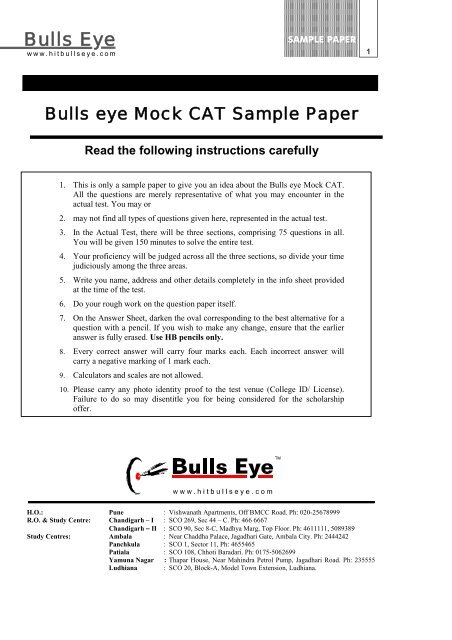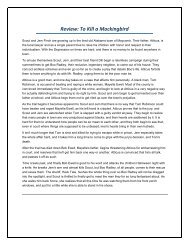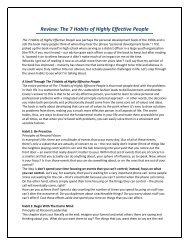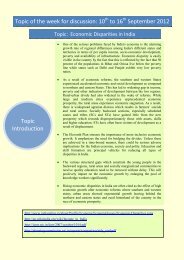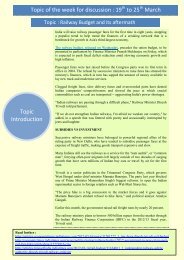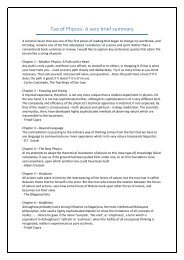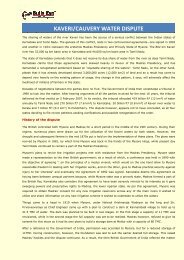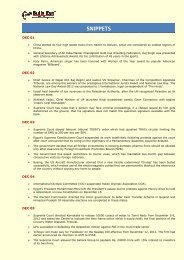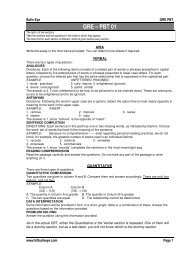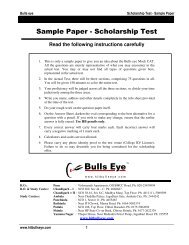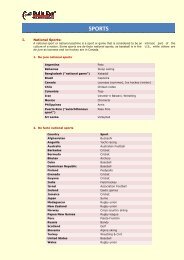Download Sample Paper - Bulls Eye
Download Sample Paper - Bulls Eye
Download Sample Paper - Bulls Eye
You also want an ePaper? Increase the reach of your titles
YUMPU automatically turns print PDFs into web optimized ePapers that Google loves.
<strong>Bulls</strong> <strong>Eye</strong><br />
www.hitbullseye.com<br />
f<br />
SAMPLE PAPER<br />
<strong>Bulls</strong> eye Mock CAT <strong>Sample</strong> <strong>Paper</strong><br />
Read the following instructions carefully<br />
1. This is only a sample paper to give you an idea about the <strong>Bulls</strong> eye Mock CAT.<br />
All the questions are merely representative of what you may encounter in the<br />
actual test. You may or<br />
2. may not find all types of questions given here, represented in the actual test.<br />
3. In the Actual Test, there will be three sections, comprising 75 questions in all.<br />
You will be given 150 minutes to solve the entire test.<br />
4. Your proficiency will be judged across all the three sections, so divide your time<br />
judiciously among the three areas.<br />
5. Write you name, address and other details completely in the info sheet provided<br />
at the time of the test.<br />
6. Do your rough work on the question paper itself.<br />
7. On the Answer Sheet, darken the oval corresponding to the best alternative for a<br />
question with a pencil. If you wish to make any change, ensure that the earlier<br />
answer is fully erased. Use HB pencils only.<br />
8. Every correct answer will carry four marks each. Each incorrect answer will<br />
carry a negative marking of 1 mark each.<br />
9. Calculators and scales are not allowed.<br />
10. Please carry any photo identity proof to the test venue (College ID/ License).<br />
Failure to do so may disentitle you for being considered for the scholarship<br />
offer.<br />
H.O.: Pune : Vishwanath Apartments, Off BMCC Road. Ph: 020-25678999<br />
R.O. & Study Centre: Chandigarh – I : SCO 269, Sec 44 – C. Ph: 466 6667<br />
Chandigarh − II : SCO 90, Sec 8-C, Madhya Marg, Top Floor. Ph: 4611111, 5089389<br />
Study Centres: Ambala : Near Chaddha Palace, Jagadhari Gate, Ambala City. Ph: 2444242<br />
Panchkula : SCO 1, Sector 11, Ph: 4655465<br />
Patiala : SCO 108, Chhoti Baradari. Ph: 0175-5062699<br />
Yamuna Nagar : Thapar House, Near Mahindra Petrol Pump, Jagadhari Road. Ph: 235555<br />
Ludhiana : SCO 20, Block-A, Model Town Extension, Ludhiana.<br />
1
2<br />
SAMPLE PAPER<br />
SECTION - I<br />
<strong>Bulls</strong> <strong>Eye</strong><br />
www.hitbullseye.com<br />
DIRECTIONS for questions 1 to 10: Answer each of the following questions to the best of your ability.<br />
1. The length, breadth and height of a room are in the ratio 3:2:1. If the breadth and height are halved<br />
while the length is doubled, then the total area of the four walls of the room will<br />
1. remain the same 2. decrease by 13.64%<br />
3. decrease by 30% 4. decrease by 18.75%<br />
2. A semi-circle is drawn with AB as its diameter. From C, a point on AB, a line perpendicular to AB<br />
is drawn meeting the circumference of the semi-circle at D. Given that AC = 2 cm and CD = 6 cm,<br />
the area of the semi-circle (in sq. cm) will be:<br />
1. 32 π 2. 50 π ` 3. 40.5 π 4. 81 π<br />
3. If x = (16 3 + 17 3 + 18 3 + 19 3<br />
), then x when divided by 70 leaves a remainder of<br />
1. 0 2. 1 3. 69 4. 35<br />
4. Two identical circles intersect so that their centres, and the points at which they intersect, form a<br />
square of side 1 cm. The area in sq. cm of the portion that is common to the two circles is<br />
π<br />
1. 2. 1<br />
4<br />
2 −<br />
π<br />
π<br />
3. 4. 2 − 1<br />
5<br />
5. Uncle Bert was making porridge in a cylindrical pan of diameter 24cm. The spoon he was using is<br />
26 cm long. It accidentally falls and sinks into the porridge. Calculate the minimum volume of<br />
porridge necessary to hide the spoon. You may ignore the volume of the spoon.<br />
1. 5523.9cm 3 2. 6525.9cm 3 3. 4225.9cm 3 4. 4525.9cm 3<br />
6. The digits of a three digit number A are written in the reverse order to form another three digit<br />
number B. If B > A and B – A is perfectly divisible by 7, then which of the following is necessarily<br />
true?<br />
1. 100 < A < 299 2. 106 < A < 305<br />
3. 112 < A < 311 4. 118 < A < 317<br />
7. If a1 = 1 and an+1 – 3an + 2 = 4n for positive integer n, then a100 equals<br />
1. 3 99 - 200 2. 3 99<br />
+ 200<br />
100 100<br />
3. 3 – 200 4. 3 + 200<br />
8. The rightmost non – zero digit of the number 30 2720<br />
is<br />
1. 5 2. 3 3. 7 4. 1<br />
9. The sides of a triangle are in the ratio of 1/2 : 1/3 : 1/4. If the perimeter is 52 cm, the length of the<br />
smallest side is<br />
1. 9 cm 2. 10 cm 3. 12 cm 4. 11 cm<br />
10. For a positive integer n, let pn denote the product of the digits of n, and sn denote the sum of the<br />
digits of n. The number of integers between 10 and 1000 for which pn + sn = n is<br />
1. 81 2. 16 3. 18 4. 9
<strong>Bulls</strong> <strong>Eye</strong><br />
www.hitbullseye.com<br />
SECTION - II<br />
SAMPLE PAPER<br />
DIRECTIONS for questions 11 to 14: Answer these questions on the basis of the information given below.<br />
The following table gives details regarding the total earnings of 15 employees and the number of days they<br />
have worked on complex, medium and simple operation in the month of June 2002. Even though the<br />
employees might have worked on an operation, they would be eligible for earnings only if they have<br />
minimum level of efficiency.<br />
Total Earnings<br />
Total Days<br />
Emp. No Complex Mediu<br />
m<br />
Simple Total Complex Medium Simple Total<br />
2001147 82.98 636.53 719.51 3.00 0.00 23.00 26.00<br />
2001148 51.53 461.73 513.26 3.33 1.67 16.00 21.00<br />
2001149 171.17 79.10 250.81 5.50 4.00 8.50 18.00<br />
2001150 100.47 497.47 597.95 6.00 4.67 7.33 18.00<br />
2001151 594.43 159.64 754.06 9.67 13.33 0.00 23.00<br />
2001156 89.70 89.70 8.00 0.00 1.00 9.00<br />
2001158 472.31 109.73 582.04 1.39 9.61 0.00 11.00<br />
2001164 402.25 735.22 213.67 1351.14 5.27 12.07 0.67 18.00<br />
2001170 576.57 576.57 21.00 0.00 0.00 21.00<br />
2001171 286.48 6.10 292.57 8.38 4.25 0.38 13.00<br />
2001172 512.10 117.46 629.56 10.00 8.50 0.350.5 22.00<br />
2001173 1303.88 1303.88 25.50 0.00<br />
0<br />
0.00 26.00<br />
2001174 1017.94 1017.94 26.00 0.00 0.00 26.00<br />
2001179 46.56 776.19 822.75 2.00 19.00 0.00 21.00<br />
2001180 116.40 1262.79 1379.19 5.00 19.00 0.00 24.00<br />
11. The number of employees who have earned more than 50 rupees per day in complex operations is<br />
1. 4 2. 3 3. 5 4. 6<br />
12. The number of employees who have earned more than 600 rupees and having more than 80%<br />
attendance(there are 25 regular working days in June 2002; some might be coming on overtime too)<br />
is<br />
1. 4 2. 6 3. 5 4. 7<br />
13. The employee number of the person who has earned the maximum earnings per day in medium<br />
operation is<br />
1. 2001173 2. 2001164 3. 2001172 4. 2001180<br />
14. Among the employees who were engaged in complex and medium operations, the number of<br />
employees whose average earning per day in complex operations is more than average earning per<br />
day in medium operations is<br />
1. 2 2. 3 3. 5 4. 4<br />
3
4<br />
SAMPLE PAPER<br />
<strong>Bulls</strong> <strong>Eye</strong><br />
www.hitbullseye.com<br />
DIRECTIONS for questions 15 to17: Answer these questions on the basis of the information given below.<br />
The table below reports annual statistics related to rice production in select states of India for a particular<br />
year.<br />
State Total Area<br />
(in million<br />
hectares)<br />
% of Area Under<br />
Rice Cultivation<br />
Production<br />
(in million<br />
tons)<br />
Population<br />
(in millions)<br />
Himachal Pradesh 6 20 1.2 6<br />
Kerala 4 60 4.8 32<br />
Rajasthan 34 20 6.8 56<br />
Bihar 10 60 12 83<br />
Karnataka 19 50 19 53<br />
Haryana 4 80 19.2 21<br />
West Bengal 9 80 21.6 80<br />
Gujarat 20 60 24 51<br />
Punjab 5 80 24 24<br />
Madhya Pradesh 31 40 24.8 60<br />
Tamil Nadu 13 70 27.3 62<br />
Maharashtra 31 50 48 97<br />
Uttar Pradesh 24 70 67.2 166<br />
Andhra Pradesh 28 80 112 76<br />
15. Which two states account for the highest productivity of rice (tons produced per hectare of rice<br />
cultivation)?<br />
1. Haryana and Punjab 2. Punjab and Andhra Pradesh<br />
3. Andhra Pradesh and Haryana 4. Uttar Pradesh and Haryana<br />
16. How many states have a per capita production of rice (defined as total rice production divided by its<br />
population) greater than Gujarat?<br />
1. 3 2. 4 3. 5 4. 6<br />
17. An intensive rice producing state is defined as one whose annual rice production per million of<br />
population is at least 400,000 tons. How many states are intensive rice producing states?<br />
1. 5 2. 6 3. 7 4. 8
<strong>Bulls</strong> <strong>Eye</strong><br />
www.hitbullseye.com<br />
SAMPLE PAPER<br />
DIRECTIONS for questions 18 to 20: Answer these questions on the basis of the information given below.<br />
The Dean’s office recently scanned students’ results into the central computer system. When their character<br />
reading software cannot read something, it leaves that space blank. The scanner output reads as follows:<br />
Name Finance Marketing Statistics Strategy Operations GPA<br />
Aparna B F 1.4<br />
Bikas D D F F<br />
Chandra D A F F 2.4<br />
Deepak A B D D 3.2<br />
Fazal D F B D 2.4<br />
Gowri C C A B 3.8<br />
Hari B A D 2.8<br />
Ismet B A<br />
Jagdeep A A B C 3.8<br />
Kunal F A F F 1.8<br />
Leena B A B F 3.2<br />
Manab A B B<br />
Nisha A D B A F 3.6<br />
Osman C B B A 4.6<br />
Preeti F D D 3.2<br />
Rahul A C A F 4.2<br />
Sameer C F B<br />
Tara B 2.4<br />
Utkarsh F C A 3.0<br />
Vipul A C C F 2.4<br />
In the grading system, A, B, C, D, and F grades fetch 6, 4, 3, 2, and 0 grade respectively. The Grade Point<br />
Average (GPA) is the arithmetic mean of the grade points obtained in the five subjects. For example Nisha’s<br />
GPA is (6 + 2 + 4 + 6 + 0)/5 = 3.6.<br />
Some additional facts are also known about the student’s grades. These are<br />
(a) Vipul obtained the same grade in Marketing as Aparna obtained in Finance and Strategy.<br />
(b) Fazal obtained the same grade in Strategy as Utkarsh did in Marketing.<br />
(c) Tara received the same grade in exactly three courses.<br />
18. What grade did Preeti obtain in Statistics?<br />
1. A 2. B 3. C 4. D<br />
19. What grade did Utkarsh obtain in Finance?<br />
1. A 2. B 3. C 4. D<br />
20. In Strategy, Gowri’s grade point was higher than that obtained by<br />
1. Fazal 2. Hari 3. Nisha 4. Rahul<br />
5
6<br />
SAMPLE PAPER<br />
SECTION - III<br />
<strong>Bulls</strong> <strong>Eye</strong><br />
www.hitbullseye.com<br />
DIRECTIONS for questions 21 to 24: The passage given below is followed by a set of questions each.<br />
Choose the most appropriate answer to each question on the basis of what is written/ or implied therein.<br />
PASSAGE - A<br />
Telepathy, or the supposed communication between two minds by extrasensory means, has long been held in<br />
healthy contempt by mainstream scientists. Ironically though, these same people are now conducting a<br />
revolutionary experiment in London which, if it succeeds, will sneakily usher in the voodoo phenomenon<br />
through the backdoor and make it potentially available off the shelf to anyone in the world. That’s called<br />
progress by hindsight.<br />
It is quite simple what they plan to do actually. Surgeons at Stoke Mandeville Hospital are implanting a<br />
computerized electrode in the arm of a British professor and his wife to see if they can communicate with<br />
each other using just thought alone. For instance, if the man wants to move his index finger, then the<br />
electrode which is connected to his nerve fibres would pick up the nerve signals, convert it to radio waves,<br />
and transmit it to an external computer. This computer would then immediately re-transmit it to the implant<br />
in his wife’s arm. Meaning when the professor wishes to move his index finger his brain would also be able<br />
to move his wife’s index finger.<br />
The experiment is being touted as something that may one day lead to a new treatment for paralysis victims<br />
but can anyone really be fooled that the good doctors are, in the process, also hooking up two brains? For<br />
instance, emotions like excitement and anger, which also stimulate nerve activity, could be as easily<br />
transferred from one individual to another independent of speech, body language or any of the other<br />
recognized channels of sense. “Gee, that makes me mad,” thinks the professor and “Uh oh,” goes his wife<br />
instantly, “he has blown a fuse”.<br />
Is this going to lead to a world in the future where everybody’s nervous systems are interconnected or what?<br />
In fact, that’s always been one of the philosophical problems with telepathy – we may be able to empathize<br />
with a near and dear one instantaneously but what happens to individual privacy when our innermost<br />
thoughts are thrown open to the public at large? How do you plan a battle strategy, a hostile company<br />
takeover or a defence argument in court?<br />
21. The author’s plan of action consists of<br />
1. Presenting a theory followed by empirical data to support it.<br />
2. Introducing a new idea and supporting it with multiple sources.<br />
3. Defining a phenomenon, talking about a new experiment to verify it and asking some relevant<br />
questions.<br />
4. Comparing two rival theories regarding telepathy and deciding which one is a better option<br />
22. The author could have given which of the following titles to this passage?<br />
1. Telepathy: Nothing New About It 2. Telepathy In Modern Science<br />
3. New Research In Telepathy 4. New Psychological Research<br />
23. What has been the scientists’ stand on telepathy so far?<br />
1. They have been indifferent to it<br />
2. They have scoffed at it<br />
3. They have been willing to accept it<br />
4. The passage does not say any thing in his regard.<br />
24. This passage could not have been a part of<br />
1. An old psychology text book 2. A newspaper’s Sunday supplement<br />
3. A current affairs magazine 4. A psychology research journal
<strong>Bulls</strong> <strong>Eye</strong><br />
www.hitbullseye.com<br />
SAMPLE PAPER<br />
DIRECTIONS for questions 25 to 26: Each of the following questions has a paragraph from which the last<br />
sentence has been deleted. From the given options, chose the one that completes the paragraph in the most<br />
appropriate way.<br />
25. Age has a curvilinear relationship with the exploitation of opportunity. Initially, age will increase the<br />
likelihood that a person will exploit an entrepreneurial opportunity because people gather much of<br />
the knowledge necessary to exploit opportunities over the course of their lives, and because age<br />
provides credibility in transmitting that information to others. However, as people become older, their<br />
willingness to bear risks declines, their opportunity costs rise, and they become less receptive to new<br />
information. _______________________<br />
1. As a result, people transmit more information rather than experiment with new ideas as they<br />
reach an advanced age.<br />
2. As a result, people are reluctant to experiment with new ideas as they reach an advanced age.<br />
3. As a result, only people with lower opportunity costs exploit opportunity when they reach an<br />
advanced age.<br />
4. As a result, people become reluctant to exploit entrepreneurial opportunities when they reach an<br />
advanced age.<br />
26. Most firms consider expert individuals to be too elitist, temperamental, egoist, and difficult to work<br />
with. Force such people to collaborate on a high-stakes project and they might come to blows. Even<br />
the very idea of managing such a group seems unthinkable. So most organizations adopt the default<br />
option, setting up project teams of people, who get along nicely. _______________________<br />
1. The result, however, is disastrous.<br />
2. The result is mediocrity.<br />
3. The result is creation of experts who then become elitists.<br />
4. Naturally they drive innovations.<br />
DIRECTIONS for questions 27 to 28: Each of the following questions has a paragraph with one italicized<br />
word that does not make sense. Choose the most appropriate replacement for that word from the options<br />
below the paragraph.<br />
27. Intelligent design derives from an early 19 th<br />
-century explanation of the natural world given by an<br />
English clergyman, William Paley. Paley was the popularizer of the famous watchmaker analogy.<br />
Proponents of intelligent design are crupping Paley’s argument with a new gloss from molecular<br />
biology.<br />
1. destroying 2. testing<br />
3. resurrecting 4. questioning<br />
28. It is klang to a sensitive traveller who walks through this great town, when he sees the streets, the<br />
roads, and cabin doors crowded with beggars, mostly women, followed by three, four, or six<br />
children, all in rags and troubling every passenger for alms.<br />
1. amusing 2. irritating<br />
3. disgusting 4. distressing<br />
7
8<br />
SAMPLE PAPER<br />
<strong>Bulls</strong> <strong>Eye</strong><br />
www.hitbullseye.com<br />
DIRECTIONS for questions 29 to 30: Each of the following questions consists of a sentence, with some<br />
parts of it underlined, which could be erroneous. From among the choices given, you have to select an<br />
answer that is the best possible replacement for the underlined part of the key sentence. While choosing the<br />
right answer, please pay particular attention to the syntax, idiom, usage and economy of words being used.<br />
29. A Labor Department study states that the numbers of women employed outside the home grew by<br />
more than a thirty-five percent increase in the past decade and accounted for more than sixty-two<br />
percent of the total growth in the civilian work force.<br />
1. numbers of women employed outside the home grew by more than a thirty-five percent increase<br />
2. numbers of women employed outside the home grew more than thirty-five percent<br />
3. numbers of women employed outside the home were raised by more than thirty-five percent<br />
4. number of women employed outside the home increased by more than thirty-five percent<br />
30. A new phenomena, which is visible at Managua’s major intersections, are waves of vendors and<br />
beggars, which include many children and mob cars at the stoplights.<br />
1. A new phenomena, which is visible at Managua’s major intersections, are waves of vendors and<br />
beggars, which include many children and<br />
2. Visible at Managua’s major intersections are waves of vendors and beggars with many children,<br />
new phenomena that<br />
3. A new phenomenon visible at Managua’s major intersections is waves of vendors and beggars,<br />
many of them children, who<br />
4. Phenomenally new waves of vendors, beggars, and many children are visible at Managua’s major<br />
intersections, which<br />
Answer Key To <strong>Sample</strong> Test<br />
1. 3 11. 3 21. 3<br />
2. 2 12. 4 22. 3<br />
3. 1 13. 4 23. 1<br />
4. 2 14. 1 24. 2<br />
5. 4 15. 1 25. 4<br />
6. 2 16. 2 26. 2<br />
7. 3 17. 4 27. 3<br />
8. 4 18. 1 28. 3<br />
9. 3 19. 4 29. 4<br />
10. 4 20. 2 30. 3


